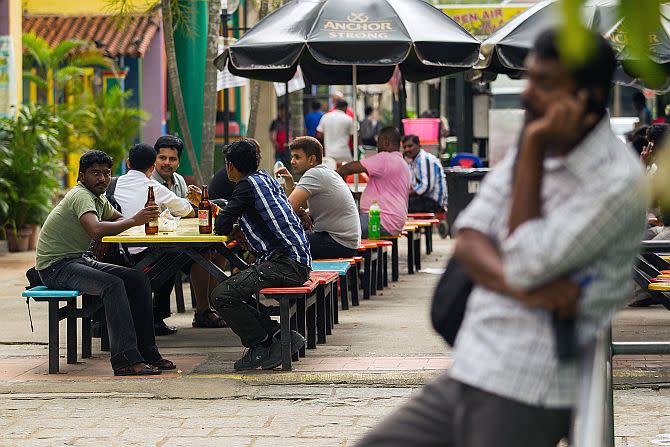Immigration and the Singapore Identity
The furore following Member of Parliament Denise Phua’s statement describing congregations of foreign workers as “walking time-bombs” reflects Singapore’s ambivalence towards the presence of foreigners. Representing her constituency of Jalan Besar, Ms Phua had proposed fencing off communal areas to keep foreign workers out, no doubt in response to concerns from local citizens. While our society needs the services of foreign workers, many Singaporeans are uneasy about the impact of their influx on matters ranging from safety to the condition of local culture.
So where do we go from here? To start with, perhaps it would be useful look at the example of the most well-known immigrant society of all – The United States of America.
A hundred years ago, immigrants first arriving at New York City would have disembarked in full view of the Statue of Liberty, a monument that Franklin D. Roosevelt honoured in 1936 as an icon of immigration. Today, 80 years later, aspiring American presidential candidate Donald Trump is able to capitalise on a groundswell of discontent with immigration for his campaign.
How did a nation of immigrants and the richest country in the world end up with this much disdain for something that lies at the foundation of its society?
The truth is (new) immigration has always been an issue among the American public. Recent immigrants have often been looked at as a threat to American values. If this sounds familiar to us in Singapore, that would be because the theme of cultural difference is universal. And, just as ironically, we too are a nation built on immigration.
By now, multiracialism and multiculturalism are no longer radical ideas. Yet many modern societies are struggling with the question of immigration, a perennial issue punctuated by shocks such as terrorism and the influx of refugees. In Singapore, where a nation of millions must live together in a tight space, this question is perhaps even more salient. Can our society handle large numbers of immigrants?
With the non-resident population making up slightly more than a quarter of the total population, Singaporeans are naturally concerned about the competition for jobs, the erosion of national identity and overcrowding. As the arrest of 27 Bangladeshi workers under the ISA reminds us, there are also concerns about security and the threat of radicalised groups or criminals finding their way into the country.
Most of these problems could be seen as matters of governance, things that can perhaps be left to experts and officials. However, something that our penchant for hard-headed policymaking and planning alone cannot resolve is the issue of Singapore’s culture and identity. We need to decide as a society what our culture and identity will look like in the coming decades, and this is a process that has no correct answers.

Foreign workers enjoying their break in Little India. (Photo: Nicky Loh)
There are three distinct paths that we can go down. One is the American ‘melting pot’ model of conflict and natural assimilation: There is little or no government intervention and immigrants are left to form self-reliant enclaves. Historically, these groups were often hostile to each other and to the ‘locals’, even spawning violent gangs that featured notorious characters such as Al Capone. Only after generations did these groups eventually assimilate into American society, becoming part of the tapestry of American culture with contributions such as Italian American cuisine and common Yiddish loanwords like ‘chutzpah’.
This path is the least likely to be deliberately chosen in Singapore due to our size and perceived vulnerability to any social instability or disharmony that might result.
The second way is to define what Singaporean culture and identity are and use them as benchmarks for ‘Singaporeanness’ in assimilating immigrants. This could be done by returning to classic or mythologised ideas of what it means to be Singaporean or by synthesising those ideas today. There is a tendency for members of the public to engage in this when they treat qualities such as the ability to speak Singlish correctly as identity markers and yardsticks for ‘Singaporeanness’. Similarly, when Member of Parliament Darryl David proposed that English proficiency should be a criterion for citizenship, he was essentially advocating the same path.
While it might be the most intuitive method for many Singaporeans, this path is also likely to be exclusionary as it sets a high bar for assimilation for immigrants, many of whom come from cultures that are very different from ours. If integration is a goal, this method might even make the process more difficult.
The third path is to include immigrants’ culture as part of a new and evolving Singaporean identity. This would entail fusing elements of the different cultures with local Singapore culture to create an inclusive model. For example, local languages and Singlish could expand to include Mainland Chinese, Filipino or Bangladeshi words, while food from the different immigrant communities could be included as staples of local cuisine.
From the perspective of integration, this would be the easiest path as it allows immigrants to retain their identity to some extent and feel a sense of familiarity towards local culture. However, in practice, it would likely encounter difficulties arising from resentment among local Singaporeans, many of whom might feel that the local culture is being watered down.
In the end, the likelihood is no matter how we go about trying to resolve the question of our culture and identity, our approach will end up being an amalgamation of these three paths. Nonetheless, one of them will likely be the dominant path, and that will determine much of what our sense of community and social fabric will be like in the decades to come.
Top photo: Our version of the Statue of Liberty, Shahwaz Beg



